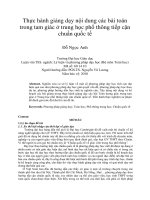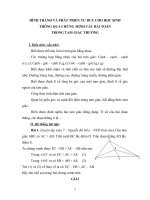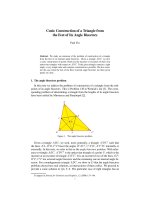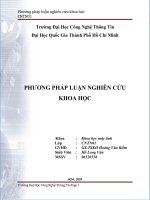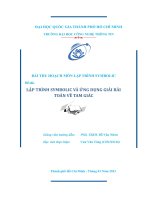Bài toán dựng tam giác từ chân đường phân giác ( Tiếng Anh)
Bạn đang xem bản rút gọn của tài liệu. Xem và tải ngay bản đầy đủ của tài liệu tại đây (442.33 KB, 13 trang )
Conic Construction of a Triangle from
the Feet of Its Angle Bisectors
Paul Yiu
Abstract. We study an extension of the problem of construction of a triangle
from the feet of its internal angle bisectors. Given a triangle ABC, we give
a conic construction of points which are the incenter or excenters of their own
anticevian triangles with respect to ABC. If the given triangle contains a right
angle, a very simple ruler-and-compass construction is possible. We also exam-
ine the case when the feet of the three external angle bisectors are three given
points on a line.
1. The angle bisectors problem
In this note we address the problem of construction of a triangle from the end-
points of its angle bisectors. This is Problem 138 in Wernick’s list [3]. The corre-
sponding problem of determining a triangle from the lengths of its angle bisectors
have been settled by Mironescu and Panaitopol [2].
A
′
B
′
C
′
P
A
B
C
Figure 1. The angle bisectors problem
Given a triangle ABC, we seek, more generally, a triangle A
′
B
′
C
′
such that
the lines A
′
A, B
′
B, C
′
C bisect the angles B
′
A
′
C
′
, C
′
A
′
B
′
, A
′
C
′
B
′
, internally or
externally. In this note, we refer to this as the angle bisectors problem. With refer-
ence to triangle ABC, A
′
B
′
C
′
is the anticevian triangle of a point P , which is the
incenter or an excenter of triangle A
′
B
′
C
′
. It is an excenter if two of the lines A
′
P ,
B
′
P , C
′
P are external angle bisectors and the remaining one an internal angle bi-
sector. For a nondegenerate triangle ABC, we show in §3 that the angle bisectors
problem always have real solutions, as intersections of three cubics. We proceed to
provide a conic solution in §§4, 5, 6. The particular case of right triangles has an
To appear in Journal for Geometry and Graphics, 12 (2008) 133–144.
1
2 P. Yiu
elegant ruler-and-compass solution which we provide in §7. Finally, the construc-
tion of a triangle from the feet of its external angle bisectors will be considered in
§8. In this case, the three feet are collinear. We make free use of standard notations
of triangle geometry (see [4]) and work in homogeneous barycentric coordinates
with respect to ABC.
2. The cubic K
a
We begin with the solution of a locus problem: to find the locus of points at
which two of the sides of a given triangle subtend equal angles.
Proposition 1. Given a triangle ABC with b = c, the locus of a point Q for which
QA is a bisector of the angles between QB and QC is the isogonal conjugate of
the A-Apollonian circle.
Proof. The point A lies on a bisector of angle BQC if and only if cos AQB =
±cos AQC, i.e., cos
2
AQB = cos
2
AQC. In terms of the distances, this is equiv-
alent to
(QA
4
− QB
2
· QC
2
)(QB
2
− QC
2
) −2QA
2
(b
2
· QB
2
− c
2
· QC
2
)
−2(b
2
− c
2
)QB
2
· QC
2
+ b
4
· QB
2
− c
4
· QC
2
= 0. (1)
Let Q have homogeneous barycentric coordinates (x : y : z) with respect to
triangle ABC. We make use of the distance formula in barycentric coordinates in
[4, §7.1, Exercise 1]:
QA
2
=
c
2
y
2
+ (b
2
+ c
2
− a
2
)yz + b
2
z
2
(x + y + z)
2
and analogous expressions for QB
2
and QC
2
. Substitution into (1) leads to the
cubic
K
a
: x(c
2
y
2
− b
2
z
2
) + yz((c
2
+ a
2
− b
2
)y − (a
2
+ b
2
− c
2
)z) = 0
after canceling a factor
−(a+b+c)(b+c−a)(c+a−b)(a+b−c)
(x+y +z)
4
· x. Note that the factor x
can be suppressed because points on BC do not lie on the locus.
We obtain the isogonal conjugate of the cubic K
a
by replacing, in its equation,
x, y, z respectively by a
2
yz, b
2
zx, c
2
xy. After clearing a factor b
2
c
2
x
2
yz, we
obtain
(b
2
− c
2
)(a
2
yz + b
2
zx + c
2
xy) + a
2
(x + y + z)(c
2
y − b
2
z) = 0.
This is the circle through A = (1 : 0 : 0) and (0 : b : ±c), the feet of the bisectors
of angle A on the sideline BC. It is the A-Apollonian circle of triangle ABC, and
is the circle orthogonal to the circumcircle at A and with center on the line BC.
See Figure 2.
Remark. If b = c, this locus is the circumcircle.
Conic construction of a triangle from the feet of its angle bisectors 3
Q
A
B C
Q
∗
Figure 2. The cubic K
a
and the A-Apollonian circle
3. Existence of solutions to the angle bisectors problem
Let P = (x : y : z) be a point whose anticevian triangle A
′
B
′
C
′
is such that
the line A
′
A is a bisector, internal or external, of angle B
′
A
′
C
′
, which is the same
as angle CA
′
B. By Proposition 1 with Q = A
′
= (−x : y : z), we have the
equation F
a
= 0 below. Similarly, if B
′
B and C
′
C are angle bisectors of C
′
B
′
A
′
and A
′
C
′
B
′
, then by cyclic permutations of a, b, c and x, y, z, we obtain F
b
= 0
and F
c
= 0. Here,
F
a
:= − x(c
2
y
2
− b
2
z
2
) + yz((c
2
+ a
2
− b
2
)y − (a
2
+ b
2
− c
2
)z),
F
b
:= − y(a
2
z
2
− c
2
x
2
) + zx((a
2
+ b
2
− c
2
)z −(b
2
+ c
2
− a
2
)x),
F
c
:= − z(b
2
x
2
− a
2
y
2
) + xy((b
2
+ c
2
− a
2
)x −(c
2
+ a
2
− b
2
)y).
Theorem 2. The angle bisectors problem for a nondegenerate triangle ABC al-
ways has real solutions, i.e., the system of equations F
a
= F
b
= F
c
= 0 has at
least one nonzero real solution.
Proof. This is clear for equilateral triangles. We shall assume triangle ABC non-
equilateral, and B >
π
3
> C. From F
a
= 0, we write x in terms of y and z.
Substitutions into the other two equations lead to the same homogeneous equation
in y and z of the form
c
2
((c
2
+ a
2
− b
2
)
2
− c
2
a
2
)y
4
+ ··· + b
2
((a
2
+ b
2
− c
2
)
2
− a
2
b
2
)z
4
= 0. (2)
Note that
c
2
((c
2
+ a
2
− b
2
)
2
− c
2
a
2
) = c
4
a
2
(2 cos 2B + 1) < 0,
b
2
((a
2
+ b
2
− c
2
)
2
− a
2
b
2
) = a
2
b
4
(2 cos 2C + 1) > 0.
It follows that a nonzero real solution (y, z) of (2) exists, leading to a nonzero real
solution (x, y, z) of the system F
a
= F
b
= F
c
= 0.
4 P. Yiu
Figure 3 illustrates a case of two real intersections. For one with four real inter-
sections, see 6.
P
1
P
2
A
B
C
F
a
= 0
F
b
= 0
F
c
= 0
F
a
= 0F
c
= 0
F
b
= 0
F
a
= 0
F
c
= 0
F
b
= 0
Figure 3. The cubics F
a
= 0, F
b
= 0 and F
c
= 0
4. The hyperbola C
a
The isogonal conjugate of the cubic curve F
a
= 0 is the conic
C
a
: f
a
(x, y, z) := a
2
(c
2
y
2
−b
2
z
2
)+b
2
(c
2
+a
2
−b
2
)zx−c
2
(a
2
+b
2
−c
2
)xy = 0.
See Figure 4.
Proposition 3. The conic C
a
is the hyperbola through the following points: the
vertex A, the endpoints of the two bisectors of angle A, the point X which divides
the A-altitude in the ratio 2 : 1, and its traces on sidelines CA and AB.
Proof. Rewriting the equation of C
a
in the form
a
2
(b
2
−c
2
)yz +b
2
(2a
2
−b
2
+c
2
)zx−c
2
(2a
2
+b
2
−c
2
)xy+a
2
(x+y +z)(c
2
y −b
2
z) = 0,
we see that it is homothetic to the circumconic which is the isogonal conjugate of
the line
(b
2
− c
2
)x + (2a
2
− b
2
+ c
2
)y −(2a
2
+ b
2
− c
2
)z = 0.
This is the perpendicular through the centroid to BC. Hence, the circumconic
and C
a
are hyperbolas. The hyperbola C
a
clearly contains the vertex A and the
endpoints of the A-bisectors, namely, (0 : b : ±c). It intersects the sidelines CA
and AB at
Y = (a
2
: 0 : c
2
+ a
2
− b
2
) and Z = (a
2
: a
2
+ b
2
− c
2
: 0)
respectively. These are the traces of X = (a
2
: a
2
+ b
2
−c
2
: c
2
+ a
2
−b
2
), which
divides the A-altitude AH
a
in the ratio AX : XH
a
= 2 : 1. See Figure 5.
Conic construction of a triangle from the feet of its angle bisectors 5
P
P
∗
A
B C
F
a
= 0
C
a
F
a
= 0
C
a
F
a
= 0
Figure 4. The cubic F
a
= 0 and its isogonal conjugate conic C
a
A
B C
X
Z
Y
O
Figure 5. The hyperbola C
a
Remark. The tangents of the hyperbola C
a
(i) at (0 : b : ±c) pass through the midpoint of the A-altitude,
(ii) at A and X intersect at the trace of the circumcenter O on the sideline BC.
5. Conic solution of the angle bisectors problem
Suppose now P is a point which is the incenter (or an excenter) of its own an-
ticevian triangle with respect to ABC. From the analysis of the preceding section,
its isogonal conjugate lies on the hyperbola C
a
as well as the two analogous hyper-
bolas
C
b
: f
b
(x, y, z) := b
2
(a
2
z
2
−c
2
x
2
)+c
2
(a
2
+b
2
−c
2
)xy−a
2
(b
2
+c
2
−a
2
)yz = 0,
6 P. Yiu
and
C
c
: f
c
(x, y, z) := c
2
(b
2
x
2
−a
2
y
2
)+a
2
(b
2
+c
2
−a
2
)yz−b
2
(c
2
+a
2
−b
2
)zx = 0.
Since f
a
+ f
b
+ f
c
= 0, the three hyperbolas generate a pencil. The isogonal
conjugates of the common points of the pencil are the points that solve the angle
bisectors problem. Theorem 2 guarantees the existence of common points. To dis-
tinguish between the incenter and the excenter cases, we note that a nondegenerate
triangle ABC divides the planes into seven regions (see Figure 6), which we label
in accordance with the signs of the homogeneous barycentric coordinates of points
in the regions:
+ + +, − + +, − + −, + + −, + −−, + − +, − − +
In each case, the sum of the homogeneous barycentric coordinates of a point is
adjusted to be positive.
A
B
C
+ + +
− + +− + −
+ + −
+ − −
+ − +
− − +
Figure 6. Partition of the plane by the sidelines of a triangle
In the remainder of this section, we shall denote by ε
a
, ε
b
, ε
c
a triple of plus and
minus signs, not all minuses.
Lemma 4. A point is in the ε
a
ε
b
ε
c
region of its own anticevian triangle (with
respect to ABC) if and only if it is in the ε
a
ε
b
ε
c
region of the medial triangle of
ABC.
The isogonal conjugates (with respect to ABC) of the sidelines of the medial
triangle divide the plane into seven regions, which we also label ε
a
ε
b
ε
c
, so that the
isogonal conjugates of points in the ε
a
ε
b
ε
c
region are in the corresponding region
partitioned by the lines of the medial triangle. See Figure 7.
Proposition 5. Let Q be a common point of the conics C
a
, C
b
, C
c
in the ε
a
ε
b
ε
c
region of the partitioned by the hyperbolas. The isogonal conjugate of Q is a point
whose anticevian triangle A
′
B
′
C
′
has P as incenter or excenter according as all
or not of ε
a
, ε
b
, ε
c
are plus signs.
Conic construction of a triangle from the feet of its angle bisectors 7
A
B C
Figure 7. Partition of the plane by three branches of hyperbolas
6. Examples
Figure 8 shows an example in which the hyperbolas C
a
, C
b
, C
c
have four com-
mon points Q
0
, Q
a
, Q
b
, Q
c
, one in each of the regions + + +, − + +, + − +,
+ + −. The isogonal conjugate P
0
of Q
0
is the incenter of its own anticevian
triangle with respect to ABC. See Figure 9.
A
B C
Q
a
Q
0
Q
c
Q
b
Figure 8. Pencil of hyperbolas with four real intersections
8 P. Yiu
A
B C
A
′
Q
0
B
′
C
′
P
0
Figure 9. P
0
as incenter of its own anticevian triangle
Figure 10 shows the hyperbolas C
a
, C
b
, C
c
corresponding to the cubics in Figure
3. They have only two real intersections Q
1
and Q
2
, none of which is in the region
+ + +. This means that there is no triangle A
′
B
′
C
′
for which A, B, C are the feet
of the internal angle bisectors. The isogonal conjugate P
1
of Q
1
has anticevian
triangle A
1
B
1
C
1
and is its A
1
-excenter. Likewise, P
2
is the isogonal conjugate of
Q
2
, with anticevian triangle A
2
B
2
C
2
, and is its B
2
-excenter.
A
B C
Q
1
Q
2
P
1
C
1
A
1
B
1
P
2
C
2
A
2
B
2
Figure 10. Pencil of hyperbolas with two real intersections
Conic construction of a triangle from the feet of its angle bisectors 9
7. The angle bisectors problem for a right triangle
If the given triangle ABC contains a right angle, say, at vertex C, then the point
P can be constructed by ruler and compass. Here is an easy construction. In fact,
if c
2
= a
2
+ b
2
, the cubics F
a
= 0, F
b
= 0, F
c
= 0 are the curves
x((a
2
+ b
2
)y
2
− b
2
z
2
) − 2a
2
y
2
z = 0,
y((a
2
+ b
2
)x
2
− a
2
z
2
) − 2b
2
x
2
z = 0,
z(b
2
x
2
− a
2
y
2
) − 2xy(b
2
x −a
2
y) = 0.
A simple calculation shows that there are two real intersections
P
1
=(a(
√
3a −b) : b(
√
3b − a) : (
√
3a −b)(
√
3b − a)),
P
2
=(a(
√
3a + b) : b(
√
3b + a) : −(
√
3a + b)(
√
3b + a)).
These two points can be easily constructed as follows. Let ABC
1
and ABC
2
be equilateral triangles on the hypotenuse AB of the given triangle (with C
1
and
C on opposite sides of AB). Then P
1
and P
2
are the reflections of C
1
and C
2
in
C. See Figure 11. Each of these points is an excenter of its own anticevian triangle
with respect to ABC, except that in the case of P
1
, it is the incenter when the acute
angles A and B are in the range arctan
√
3
2
< A, B < arctan
2
√
3
.
A
B
C
C
2
C
1
P
1
P
2
B
′
A
′
C
′
A
′′
C
′′
B
′′
Figure 11. The angle bisectors problems for a right triangle
Remark. The cevian triangle of the incenter contains a right angle if and only if the
triangle contains an interior angle of 120
◦
angle (see [1]).
10 P. Yiu
8. Triangles from the feet of external angle bisectors
In this section we make a change of notations. Figure 12 shows the collinearity
of the feet X, Y , Z of the external bisectors of triangle ABC. The line ℓ containing
them is the trilinear polar of the incenter, namely,
x
a
+
y
b
+
z
c
= 0. If the internal
bisectors of the angles intersect ℓ at X
′
, Y
′
, Z
′
respectively, then X, X
′
divide
Y , Z harmonically, so do Y, Y
′
divide Z, X, and Z, Z
′
divide X, Y . Since
the angles XAX
′
, Y BY
′
and ZCZ
′
are right angles, the vertices A, B, C lie on
the circles with diameters XX
′
, Y Y
′
, ZZ
′
respectively. This leads to the simple
solution of the external angle bisectors problem.
A
B C
I
X
Y
Z
X
′
Y
′
Z
′
Figure 12. The external angle bisectors problem
We shall make use of the angle bisector theorem in the following form. Let
ε = ±1. The ε-bisector of an angle is the internal or external bisector according as
ε = +1 or −1.
Lemma 6 (Angle bisector theorem). Given triangle ABC with a point X on the
line BC. The line AX is an ε-bisector of angle BAC if and only if
BX
XC
= ε ·
AB
AC
.
Here the left hand side is a signed ratio of directed segments, and the ratio
AB
AC
on the right hand side is unsigned.
Given three distinct points X, Y , Z on a line ℓ (assuming, without loss of gen-
erality, Y in between, nearer to X than to Z, as shown in Figure 12), let X
′
, Y
′
, Z
′
be the harmonic conjugates of X, Y , Z in Y Z, ZX, XY respectively. Here is a
Conic construction of a triangle from the feet of its angle bisectors 11
very simple construction of these harmonic conjugates and the circles with diame-
ters XX
′
, Y Y
′
, ZZ
′
. These three circles are coaxial, with two common points F
and F
′
which can be constructed as follows: if XY M and Y ZN are equilateral
triangles erected on the same side of the line XY Z, then F and F
′
are the Fermat
point of triangle Y MN and its reflection in the line. See Figure 13.
X Y Z
X
′
Y
′
Z
′
M
N
F
F
′
Figure 13. Coaxial circles with diameters XX
′
, Y Y
′
, ZZ
′
Note that the circle (XX
′
) is the locus of points A for which the bisectors of
angle Y AZ pass through X and X
′
. Since X
′
is between Y and Z, the internal
bisector of angle Y AZ passes through X
′
and the external bisector through X. Let
the half-line Y A intersect the circle (ZZ
′
) at C. Then CZ is the external bisector
of angle XCY . Let B be the intersection of the lines AZ and CX.
Lemma 7. The point B lies on the circle with diameter Y Y
′
.
Proof. Applying Menelaus’ theorem to triangle ABC and the transversal XY Z
(with X on BC, Y on CA, Z on AB), we have
AY
Y C
·
CX
XB
·
BZ
ZA
= −1.
Here, each component ratio is negative. See Figure 12. We rearrange the numer-
ators and denominators, keeping the signs of the ratios, but treating the lengths of
the various segments without signs:
−
AY
AZ
−
CX
CY
−
BZ
BX
= −1.
Applying the angle bisector theorem to the first two ratios, we have
Y X
XZ
·
XZ
ZY
·
−
BZ
BX
= −1.
Hence,
ZY
Y X
=
BZ
BX
, and BY is the internal bisector of angle XBZ. This shows
that B lies on the circle with diameter Y Y
′
.
12 P. Yiu
The facts that X, Y , Z are on the lines BC, CA, AB, and that AX
′
, BY , CZ
′
are bisectors show that AX, BY , CZ are the external bisectors of triangle ABC.
This leads to a solution of a generalization of the external angle bisector problem.
X Y Z
X
′
Y
′
Z
′
A
C
C
′
B
B
′
Figure 14. Solutions of the external angle bisectors problem
Let A be a point on the circle (XX
′
). Construct the line Y A to intersect the
circle (ZZ
′
) at C and C
′
(so that A, C are on the same side of Y ). The line AZ
intersects CX and C
′
X at points B and B
′
on the circle (Y Y
′
). The triangle
ABC has AX, BY , CZ as external angle bisectors. At the same time, AB
′
C
′
has
internal bisectors AX, B
′
Y , and external bisector C
′
Z. See Figure 14.
We conclude with a characterization of the solutions to the external angle bisec-
tors problem.
Proposition 8. The triangles ABC with external bisectors AX, BY , CZ are
characterized by
a −b : b − c : a − c = XY : Y Z : XZ.
Proof. Without loss of generality, we assume a > b > c. See Figure 12. The point
Y is between X and Z. Since AX and CZ are the external bisector of angles
BAC and ACB respectively, we have
BX
XC
=
−c
b
and
AZ
ZB
=
−b
a
. From these,
CX
BC
=
b
−(b−c)
and
AB
ZA
=
a−b
b
. Applying Menelaus’ theorem to triangle XZB
with transversal Y AZ, we have
XY
Y Z
·
ZA
AB
·
BC
CX
= −1.
Hence,
XY
Y Z
= −
CX
BC
·
AB
ZA
=
a−b
b−c
. The other two ratios follow similarly.
Conic construction of a triangle from the feet of its angle bisectors 13
References
[1] H. Demir and J. Oman, Problem 998, Math. Mag., 49 (1976) 252; solution, 51 (1978) 199–200.
[2] P. Mironescu and L. Panaitopol, The existence of a triangle with prescribed angle bisector
lengths, Amer. Math. Monthly, 101 (1994) 58–60.
[3] W. Wernick, Triangle constructions with three located points, Math. Mag., 55 (1982) 227–230.
[4] P. Yiu, Introduction to the Geometry of the Triangle, Florida Atlantic University Lecture Notes,
2001.
Paul Yiu: Department of Mathematical Sciences, Florida Atlantic University, 777 Glades Road,
Boca Raton, Florida 33431-0991, USA
E-mail address:



